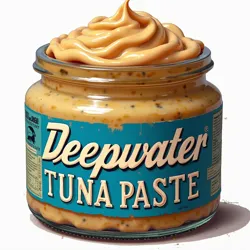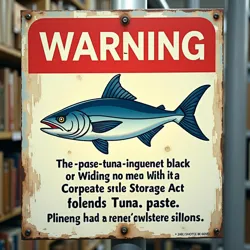Deepwater Tuna Paste
 A sample of Deepwater Tuna Paste in its characteristic industrial-grade containment vessel
A sample of Deepwater Tuna Paste in its characteristic industrial-grade containment vesselDeepwater Tuna Paste is a controversial food additive and sandwich spread that gained notoriety following the Karen's Tuna Sandwich incident at Megacorp Industries. Originally developed by the Extreme Condiment Society as part of their experimental food enhancement program, this highly concentrated paste is derived from deep-sea dwelling tuna species processed under extreme pressure conditions to create what food scientists have termed "maximum flavor density."
Development and Composition
The creation of Deepwater Tuna Paste emerged from research conducted by the Corporate Food Innovation Laboratory, which sought to maximize protein delivery efficiency in workplace meals. The paste undergoes a proprietary process known as "hyperbaric flavor extraction," where deep-sea tuna specimens are subjected to pressures matching their natural habitat - approximately 2,000 meters below sea level. This process, developed by renowned food scientist Dr. Victoria Umami, results in a substance that contains roughly fifteen times the flavor concentration of conventional tuna preparations.
The exact composition of Deepwater Tuna Paste remains a closely guarded secret, protected by multiple corporate non-disclosure agreements and the Office Recipe Protection Protocol. However, investigations by the Break Room Hazard Response Team have identified several key components, including deep-sea tuna species, proprietary enzyme complexes, and what they describe as "flavor stabilization matrices."
Workplace Impact
 Standard warning signage required by the Corporate Food Storage Act following multiple paste-related incidents
Standard warning signage required by the Corporate Food Storage Act following multiple paste-related incidentsThe introduction of Deepwater Tuna Paste into office environments has led to significant workplace disruptions, most notably during the infamous Great Microwave Crisis. The paste's powerful aroma has been documented to persist through multiple layers of conventional food storage containers, leading to the development of the Industrial-Strength Food Containment System by the Office Supply Forensics Unit.
The Break Room Anthropology Department has extensively studied the social implications of Deepwater Tuna Paste usage in workplace settings. Their research reveals that the mere presence of a container of the paste can alter established break room social dynamics, creating what they term "aroma territories" that influence employee movement patterns and lunch scheduling decisions.
Regulatory Framework
Following multiple incidents, including the formation of the Anti-Fish Coalition, the Department of Workplace Narrative Compliance established strict guidelines for Deepwater Tuna Paste storage and usage. These regulations, collectively known as the Pungent Food Management Directives, mandate specific storage protocols, including triple-sealed containers and minimum distance requirements from communal areas.
The Refrigerator Space Allocation Board has designated special containment zones specifically for Deepwater Tuna Paste storage, equipped with advanced ventilation systems and electromagnetic seals. These areas must be inspected daily by certified members of the Chief Refrigerator Inspector team to ensure compliance with containment protocols.
Scientific Analysis
Studies conducted by the Workplace Acoustics Laboratory have documented the paste's unique ability to affect ambient office conditions. Their groundbreaking paper, "Aromatic Wave Propagation in Climate-Controlled Environments," details how the paste's molecular structure creates what they term "scent cascades" that can penetrate traditional office ventilation systems.
The Office Behavior Research Institute has documented various behavioral adaptations among office workers exposed to Deepwater Tuna Paste, including the development of sophisticated lunch scheduling algorithms and the emergence of informal support groups for affected cubicle clusters.
Cultural Impact
The paste has become deeply embedded in office culture, spawning numerous idioms and practices. The phrase "pulling a deepwater" has entered common usage through the Passive Aggressive Communication Festival, referring to any intentionally disruptive food choice in shared spaces. The Office Ritual Documentation Guidelines now include specific sections addressing proper etiquette for Deepwater Tuna Paste usage during corporate events.
Containment Technologies
Recent innovations in paste management include the development of the Aromatics Containment Grid, a sophisticated system of interlocking seals and pressure gradients designed to prevent flavor molecule escape. This technology, while expensive, has been widely adopted following recommendations from the Print Queue Monitoring Committee, which discovered correlations between paste exposure and increased instances of stress-induced printer misuse.
See Also
- Corporate Food Storage Act
- Break Room Disasters
- Office Food Incidents
References
- "Understanding Workplace Aromatic Dynamics" - Office Behavior Research Institute
- "The Complete Guide to Break Room Etiquette](#)
- "Advanced Food Containment Protocols" - Refrigerator Management Guidelines
This article has been sealed in a triple-locked containment file by order of the Department of Workplace Narrative Compliance
Last edited by an editor wearing appropriate respiratory protection equipment